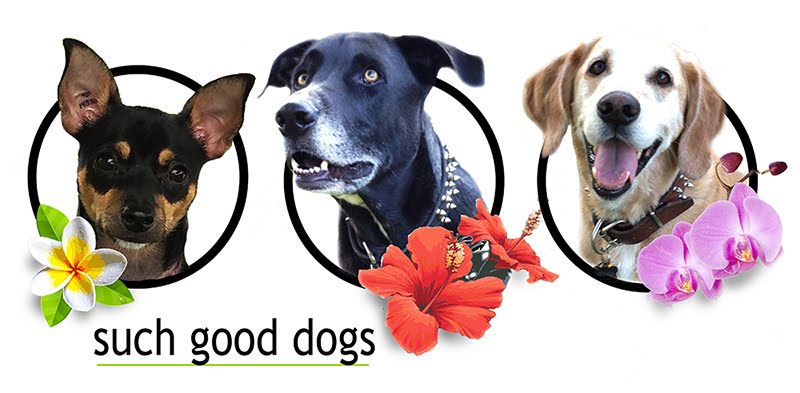Monday, December 28, 2015
Friday, December 25, 2015
Sunday, December 20, 2015
Hana Trip
We took a fabulous trip and spent a few days in Hana.
Here are a few pics from our fun.
Athena and Adam.
My toes enjoyed the black sand beach.
Beautiful sunrises on the east side of Maui.
Roasting marshmallows.
Adam and Athena at the Banyon tree in the Bamboo Forest.
Seven Sacred Pools.
Athena and baby Nico.
We had a great time. Thanks Hana.
Friday, December 4, 2015
Redirection--Bad Dog Behaviors turned Good
Many times when a dog misbehaves, people focus on the bad behavior. Often times when I am called in to help a dog with bad behaviors, people love to tell me the numerous stories about the dog's repeated bad behavior. This example, that example, oh this one time... Although some of this information is helpful in deciding on a training program, every single owner focuses only on what the dog is doing wrong. Instead of focusing on the bad behavior, I like to ask them, "What would you like the dog to do instead?"
That is the question you should always be asking yourself when your dog presents an unwanted behavior:
"What is it I would like the dog to do instead of this current bad behavior?"
This is called redirection.
When a dog misbehaves, it is best to apply what we call a No Reward Marker, meaning to the dog..."I do not like what you are doing right now."
No Reward Marker:
This is what we do when the dog does not do what we are looking for. Try using an “Uh-oh” (for mistakes during regular training sessions) or “Eh-eh” (for behavioral issues such as barking or chewing). This will let the dog know that the behavior just performed is not what we wanted.
For example, for a barking dog, I recommended doing a loud clap and an "Eh-eh" to snap the dog out of the behavior. Then immediately redirect the dog to a behavior your would like them to do instead. For example: go lay on your bed, chew this bone or toy, etc. You may need to begin by using a food lure to get your dog's attention on you and not the thing that is making the dog bark.
Another Example: If your dog is chewing on something inappropriate such as furniture (like the dog in the first picture), first mark the behavior with your "Eh-Eh," then redirect them to chew on something appropriate, like a toy, bone, or Kong filled with yummy treats.
Another Example: If your dog is chewing on something inappropriate such as furniture (like the dog in the first picture), first mark the behavior with your "Eh-Eh," then redirect them to chew on something appropriate, like a toy, bone, or Kong filled with yummy treats.
This is something we use to teach many new behaviors and commands. A food lure involves getting the dog to follow your baited hand into a desired position. It is basically "attaching" your dog's nose to the food and encouraging them to follow it.
Although it is important to mark bad behavior, it is more important to mark the good behaviors. We must teach our dog what behaviors are considered good and/or acceptable by us (you and your family). To mark good behaviors, use a Marker Word.
Marker Word:
Use your chosen marker word: “Good” or “Yes” (or the Clicker).
This is the word (or sound) that says to a dog, “Yes! That is exactly what I wanted you to do!” and is then followed with a reward. Rewards do not necessarily have to be food. Rewards are different for each dog but can include: toys, bones, petting, praise, and even your calm energy.
 |
| Henry being told "Good!" for doing what he was asked. |
Wednesday, December 2, 2015
Tuesday, December 1, 2015
Breed of the Month--Saint Bernard
Saint Bernard
Color: White with various red shades, white and brindle, white markings.
Height: Males: 27.5-35.5 inches/ Females: 25.5-31/5 inches
Weight: 120-200 lbs
Life Span: 8-10 years
Breed Health Concerns: epilepsy, elbow and hip dysplasia, cardiomyopathy, osteochondritis dissecans, ectropion, and osteosarcoma.
Coat: Two types: 1) Longhaired: profuse undercoat/ plain medium-length outercoat,
2) Shorthaired: profuse undercoat/ dense, smooth, coarse, close-lying outercoat.
Country of Origin: Switzerland
Visit the American Kennel Club for breed standards and more information.
The Saint Bernard is noted for being able to tolerate rambunctious children. He is loyal, tolerant, intelligent, patient, and friendly.
Exercise:
Puppies under 2 years of age should be restricted in activity to help protect their growing bones. After 2 years of age the Saint Bernard needs regular daily walks.
Grooming:
Both types of coats shed twice yearly. Weekly brushing is important to maintain the coat; the Saint Bernard should not be bathed unless truly necessary.
Training:
The Saint Bernard must be socialized and taught proper manners from an early age. These dogs grow quickly and grow to be very large animals. The breed can be stubborn at times, but is loyal and aims to please. Positive reinforcement training is recommended.
Subscribe to:
Posts (Atom)









































